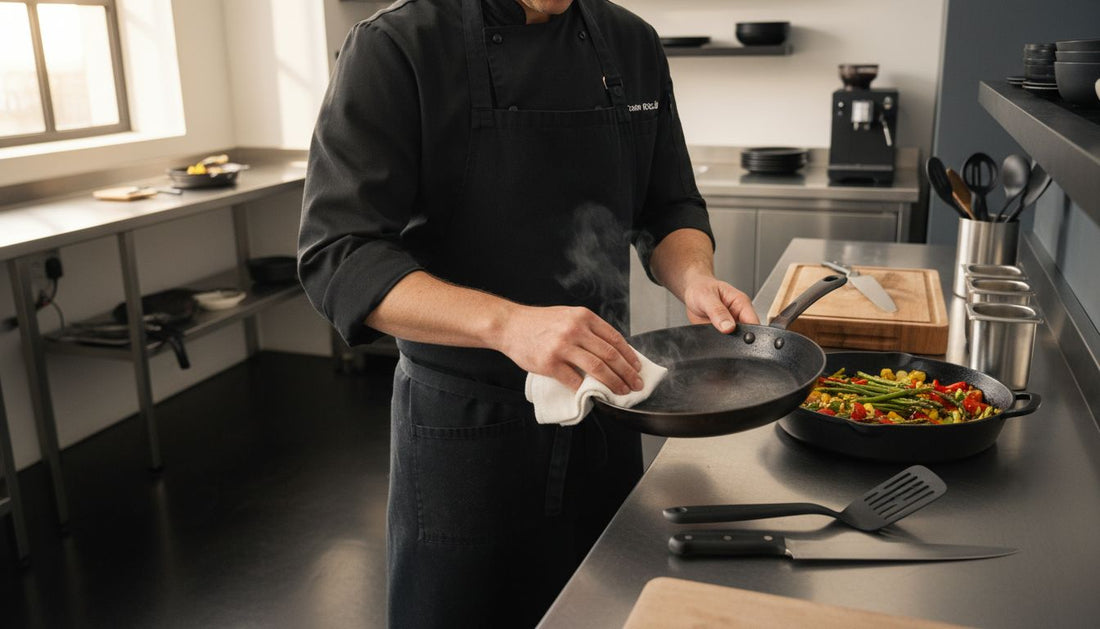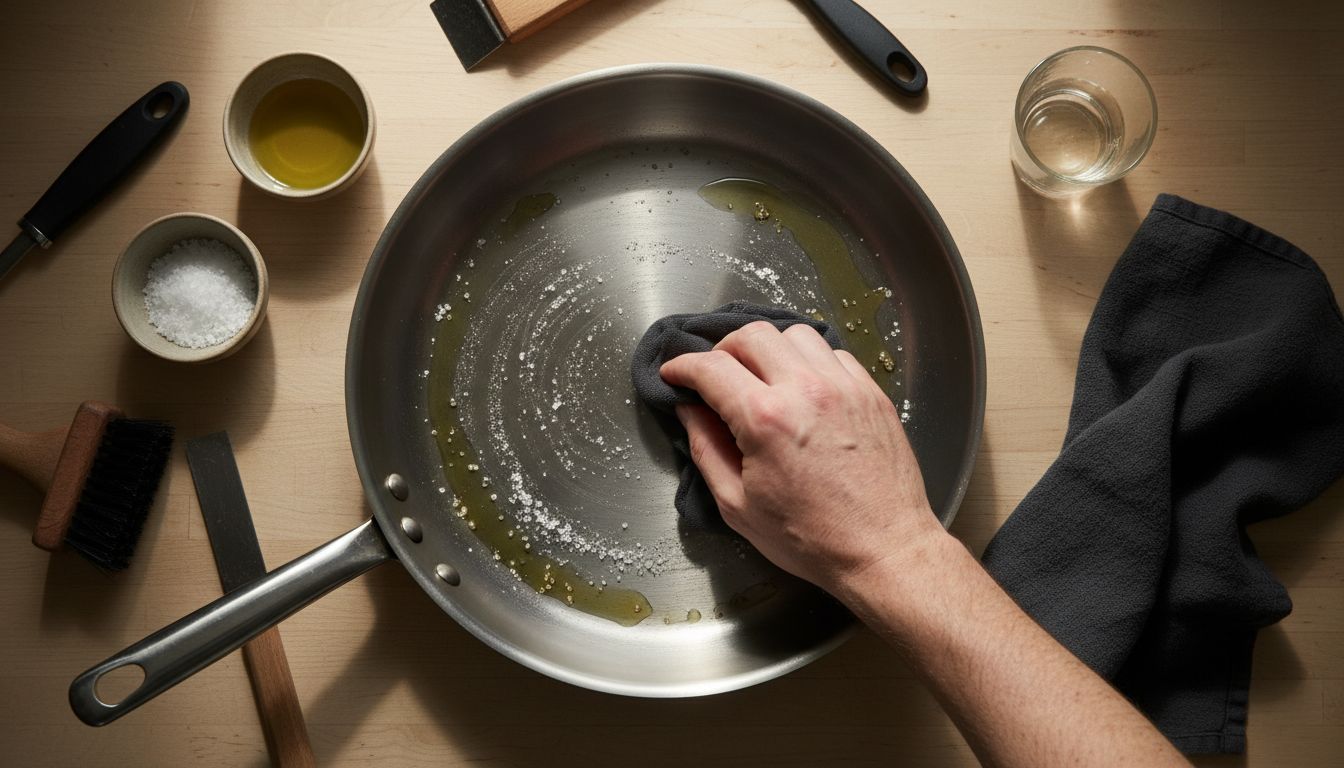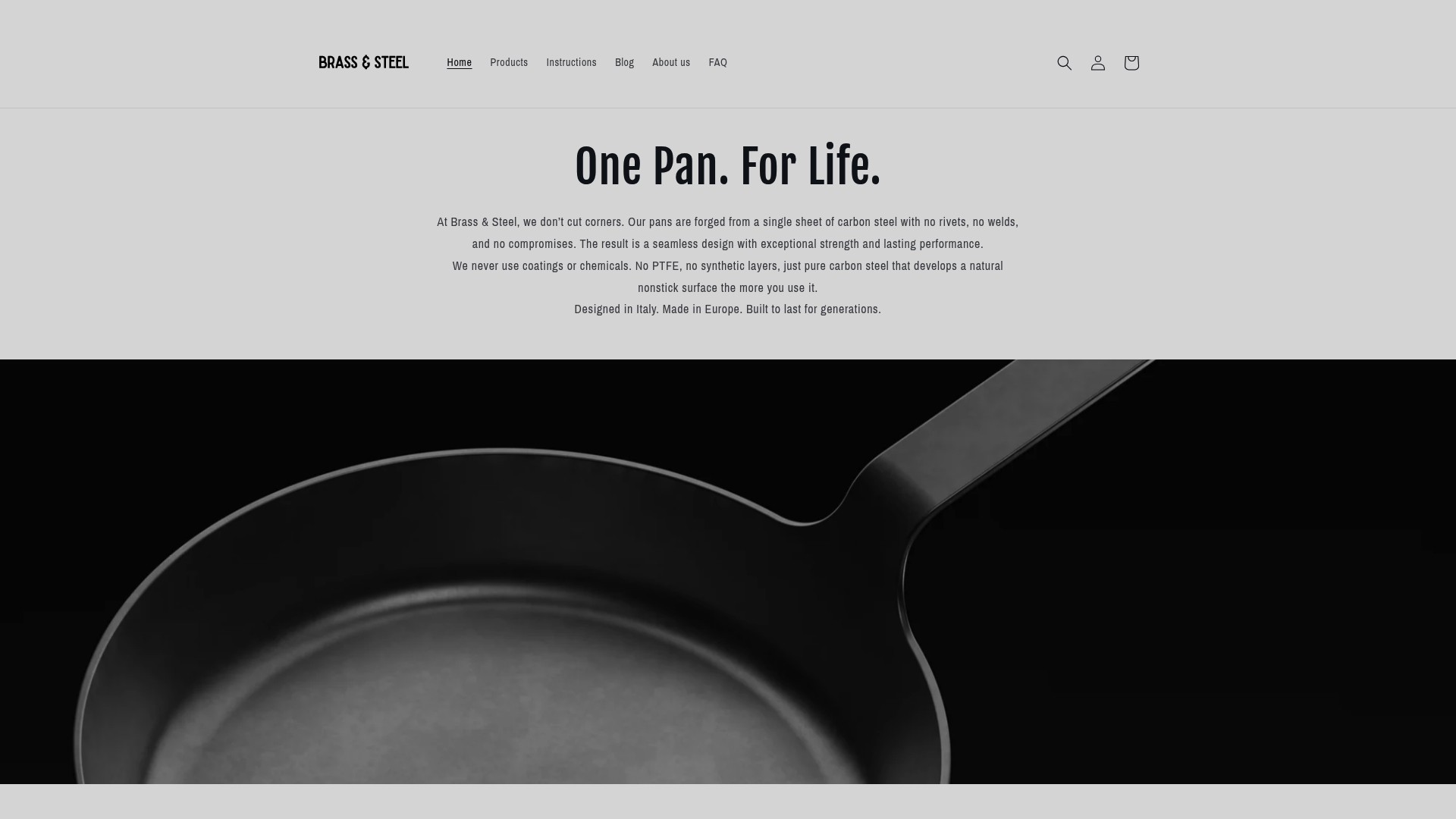
How to Clean Carbon Steel Pan Naturally: Step-by-Step Guide
Share
Did you know that improper cleaning is the top reason carbon steel pans lose their nonstick surface? Without the right care, even a well-seasoned pan can rust or lose its protective patina fast. Whether you are new to carbon steel or want to extend your pan’s life, understanding each cleaning step makes a difference. Proper habits mean you enjoy lasting performance and a pan that just gets better with time.
Table of Contents
- Step 1: Prepare Your Carbon Steel Pan for Cleaning
- Step 2: Remove Food Residue Safely Without Soaking
- Step 3: Clean the Surface Using Natural Methods
- Step 4: Dry Immediately to Prevent Rust
- Step 5: Oil Lightly to Maintain the Natural Patina
Quick Summary
| Key Point | Explanation |
|---|---|
| 1. Wipe Pan After Cooking | Allow the pan to cool slightly, then wipe with a soft cloth to prevent food residue buildup. |
| 2. Use Salt and Oil for Stuck Food | Mix coarse salt and neutral oil to gently scrub stuck food without damaging the seasoning. |
| 3. Boil Water for Tough Residue | Use warm water to loosen stubborn food particles, helping to remove them easily with minimal effort. |
| 4. Dry Immediately After Cleaning | Quickly dry the pan using medium heat to prevent moisture build-up and rust formation. |
| 5. Apply Thin Layer of Oil | After drying, lightly oil the pan to maintain its natural patina and nonstick qualities. |
Step 1: Prepare Your Carbon Steel Pan for Cleaning
Preparing your carbon steel pan for cleaning is crucial to maintaining its seasoning and preventing damage. This initial step sets the foundation for proper pan maintenance and ensures your cookware remains in top condition.
After cooking, the first rule is patience. Allow your pan to cool down slightly from cooking temperature but not completely cold. According to research from Made In Cookware, you should wipe out any remaining food particles with a paper towel or kitchen towel immediately after cooking. This prevents heavy food residues from settling and potentially damaging your pan’s seasoning.
Your goal is removing loose food bits without disrupting the protective seasoning layer. Gently wipe the pan surface using a clean paper towel or soft microfiber cloth. Move in smooth circular motions to collect any leftover food fragments. Be careful not to use abrasive materials that might scratch your pan’s surface.
Pro Tip: Always keep a dedicated soft cloth or paper towel near your cooking station for quick post-cooking cleanup.
If food seems particularly stuck, resist the urge to scrape aggressively. Instead, wait until the pan has cooled completely and use a soft cloth or gentle scraping tool designed for carbon steel. Explore our guide on best practices for carbon steel care to learn more about maintaining your cookware’s integrity.
Once you’ve removed surface debris, your pan is ready for the next cleaning stage. The key is being gentle yet thorough to preserve that beautiful seasoning you’ve worked hard to develop.
Step 2: Remove Food Residue Safely Without Soaking
Removing food residue from your carbon steel pan requires a delicate touch to preserve its seasoning and prevent potential damage. The goal is to clean effectively without compromising the protective layer you have carefully developed.
According to research from Made In Cookware, one of the most effective techniques for stubborn residue involves using a simple mixture of coarse salt and neutral oil. After your pan has cooled completely, add two tablespoons each of salt and a neutral oil like grapeseed or sunflower. This creates a gentle abrasive mixture that can help lift stuck food particles without harming your pan’s surface.
Carefully rub the salt and oil mixture across the pan using a clean towel or soft cloth. Move in circular motions to break down and remove any remaining food bits. The salt acts as a mild scrubbing agent while the oil helps protect the pan’s seasoning.

Pro Tip: Always use cold or room temperature water when cleaning to prevent thermal shock that could damage your pan.
If residue remains challenging, avoid the temptation to soak your pan. As research from Tastylicious suggests, run a small amount of warm water into the pan and gently rub with a soft sponge. This method helps remove residue while minimising potential rust formation. Learn more about safe cookware alternatives and maintenance techniques to keep your carbon steel pan in optimal condition.
Remember that gentle cleaning preserves your pan’s seasoning and ensures many years of excellent cooking performance. Patience and the right technique are key to maintaining your carbon steel cookware.
Step 3: Clean the Surface Using Natural Methods
Cleaning your carbon steel pan using natural methods helps maintain its seasoning while effectively removing stubborn food residues. The key is using gentle yet powerful techniques that protect your cookware without harsh chemicals.
According to research from Cycookery, one effective method involves using warm water and a soft cloth to wipe away initial food particles. For more challenging stuck-on bits, you can strategically boil water directly in the pan to help loosen the residue. This technique allows you to gently scrape away remaining food with a metal spatula without damaging the pan’s surface.
When dealing with particularly stubborn baked-on carbon deposits, Cycookery recommends a natural vinegar solution. Fill your pan with equal parts water and white vinegar, then bring the mixture to a gentle boil. Add two tablespoons of baking soda to create a natural cleaning agent that helps break down tough residues. After the mixture has worked its magic, use a soft sponge to carefully scrub away any remaining burnt-on bits.
Pro Tip: Always use gentle circular motions when scrubbing to prevent scratching your pan’s delicate seasoned surface.
After cleaning, thoroughly dry your pan to prevent rust formation. Check out our guide on re-seasoning your carbon steel pan to ensure your cookware remains in top condition after cleaning.
Remember that patience and gentle techniques are your best tools when maintaining a carbon steel pan. Each careful cleaning helps preserve the pan’s nonstick properties and ensures many years of excellent cooking performance.
Step 4: Dry Immediately to Prevent Rust
Preventing rust is critical to maintaining your carbon steel pan’s longevity and performance. The moments after cleaning are crucial for protecting your cookware from moisture damage that can compromise its seasoning and structural integrity.
According to research from Tastylicious, one effective method to dry your pan is using medium heat from a burner. After cleaning, place the pan over a medium heat source to help evaporate any remaining moisture quickly and thoroughly. This technique ensures complete drying while preparing the pan for its next use.
In humid climates, extra attention is necessary. Cycookery emphasizes the importance of thorough drying to prevent rust formation. After removing the pan from the heat, use a clean dry cloth to wipe down the entire surface. Pay special attention to areas where water might collect such as handle joints and the pan’s rim.
Pro Tip: Always dry your pan immediately after washing to create a protective barrier against moisture.
Learn how to maintain your carbon steel pan and prevent rust effectively to ensure your cookware remains in pristine condition for years to come.
Remember that consistent care transforms your carbon steel pan from a simple cooking tool into a treasured kitchen companion. A few extra moments of careful drying can protect your investment and enhance your cooking experience.
Step 5: Oil Lightly to Maintain the Natural Patina
Maintaining your carbon steel pan’s natural patina is essential for preserving its nonstick properties and preventing rust. The final step in your cleaning process involves applying a light protective oil layer that keeps your cookware in pristine condition.
According to research from Tastylicious, you should choose high-quality oils with high smoke points like canola or grapeseed. After thoroughly drying your pan, apply a very thin coating of oil using a clean soft cloth or paper towel. The key is creating an extremely light layer that barely covers the surface.
Cycookery emphasizes that this light oiling process helps reseason the pan and maintain its nonstick properties. Gently rub the oil into the entire surface using circular motions. Make sure to cover the interior cooking surface as well as the exterior and handle. Wipe away any excess oil to prevent pooling or sticky residue.
Pro Tip: Think of oiling as creating a microscopically thin protective shield that prevents moisture and preserves your pan’s seasoning.
Discover how carbon steel pans develop their unique patina over time and learn the secrets to maintaining its exceptional cooking performance.
Remember that consistent care transforms your carbon steel pan from a simple kitchen tool into a cherished cooking companion. Each careful oiling contributes to building a rich patina that enhances your culinary experience.
Here’s a summary of each cleaning step and its primary purpose:
| Step | Main Action | Key Purpose |
|---|---|---|
| Step 1: Prepare | Wipe pan with soft cloth | Preserve seasoning Remove debris |
| Step 2: Remove Residue | Salt & oil scrub or gentle sponge | Remove stuck-on food Avoid rust |
| Step 3: Clean Naturally | Warm water, boil, or natural solutions | Remove tough residue Gentle care |
| Step 4: Dry Immediately | Heat dry and towel wipe | Prevent rust Protect seasoning |
| Step 5: Oil Lightly | Apply thin oil layer | Maintain patina Nonstick upkeep |
Keep Your Carbon Steel Pan Pristine with Brass & Steel
Cleaning a seasoned carbon steel pan naturally can be a delicate process that requires care to preserve that cherished nonstick patina and prevent rust. If you seek a pan designed to withstand daily cooking and effortless maintenance, Brass & Steel offers premium cookware that embraces these values with every forged piece. Our pans feature a seamless single-piece construction that eliminates rivets, making cleaning simpler and helping your seasoning last longer.

Explore our Carbon Steel Collection | Brass&Steel where each pan is meticulously crafted for durability, health-conscious cooking, and excellent heat responsiveness. Start building your heirloom-quality cookware that enhances your kitchen experience and matches perfectly with the natural cleaning and maintenance methods outlined here. See the difference a well-designed carbon steel pan makes today at Brass & Steel. Take the next step towards cookware that rewards your care and skill with every meal.
Frequently Asked Questions
How do I prepare my carbon steel pan for cleaning?
To prepare your carbon steel pan for cleaning, allow it to cool slightly after cooking, then wipe out any leftover food particles with a paper towel or soft cloth. This initial step helps preserve the seasoning and prevents heavy residues from settling on the pan’s surface.
What method can I use to remove stubborn food residue without damaging the pan?
To safely remove stubborn food residue, mix two tablespoons of coarse salt with two tablespoons of neutral oil. Gently rub this mixture across the pan using a soft cloth in circular motions to lift the stuck food particles without harming the seasoning.
What natural solutions can I use for cleaning my carbon steel pan?
For natural cleaning, you can fill your pan with equal parts water and white vinegar, then bring it to a gentle boil. Adding two tablespoons of baking soda will create a natural cleaning agent that can help dissolve tough residues effectively.
How can I prevent rust after cleaning my carbon steel pan?
To prevent rust, dry your pan immediately after cleaning by placing it over medium heat or using a clean, dry cloth. Ensuring that all moisture is removed helps protect the seasoning and maintains the pan’s integrity.
How often should I oil my carbon steel pan to maintain its patina?
You should lightly oil your carbon steel pan after every cleaning session to maintain its natural patina. Apply a very thin layer of high-quality oil, such as canola or grapeseed, to help preserve the nonstick properties and prevent rust buildup.
Are there any abrasive materials I should avoid when cleaning my pan?
Yes, avoid using abrasive materials such as steel wool or rough scrubbers when cleaning your carbon steel pan. These can scratch the surface and damage the seasoning, leading to a shorter lifespan for your cookware.
Recommended
- Best Practices for Carbon Steel Care: Expert Guide – Brass & Steel
- Carbon Steel Seasoning Checklist for Lasting Nonstick Performance – Brass & Steel
- Ultimate Carbon Steel Pan Seasoning Guide for Perfect Results – Brass & Steel
- Master the Art of How to Store Carbon Steel Pans – Brass & Steel
- Oven Cleaning – 5 Ways to Remove Grease Fast | 2025 Guide